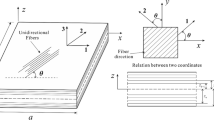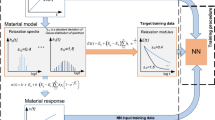Abstract
If structural reliability is estimated by following a strain-based approach, a material’s strength should be represented by the scatter of the ε–N (E–N) curves that link the strain amplitude with the corresponding statistical distribution of the number of cycles-to-failure. The basic shape of the ε–N curve is usually modelled by the Coffin–Manson relationship. If a loading mean level also needs to be considered, the original Coffin–Manson relationship is modified to account for the non-zero mean level of the loading, which can be achieved by using a Smith–Watson–Topper modification of the original Coffin–Manson relationship. In this paper, a methodology for estimating the dependence of the statistical distribution of the number of cycles-to-failure on the Smith–Watson–Topper modification is presented. The statistical distribution of the number of cycles-to-failure was modelled with a two-parametric Weibull probability density function. The core of the presented methodology is represented by a multilayer perceptron neural network combined with the Weibull probability density function using a size parameter that follows the Smith–Watson–Topper analytical model. The article presents the theoretical background of the methodology and its application in the case of experimental fatigue data. The results show that it is possible to model ε–N curves and their scatter for different influential parameters, such as the specimen’s diameter and the testing temperature.
















Similar content being viewed by others
Explore related subjects
Discover the latest articles and news from researchers in related subjects, suggested using machine learning.Notes
The S–N curve represents the dependence between the stress (usually it is an amplitude stress) and the number of cycles-to-failure at different stress levels.
The ε–N curve represents the dependence between the amplitude strain and the number of cycles-to-failure at different stress levels.
The P SWT(N f ) durability curve is in its essence merely a modified ε–N durability curve.
References
Orbanic P, Fajdiga M (1999) R&D process located at automotive industry suppliers. In: Fajdiga M, Jurejevcic T, Trenc F (eds) Proceedings of 4th conference and exhibition innovative automotive technology—IAT ‘99, Nova Gorica, Slovenia, 8th–9th April 1999, pp 233–240
Bucar T, Nagode M, Fajdiga M (2006) Predicting the scatter of S–N curves by hybrid multilayer perceptron for structural reliability evaluation. In: Soares CG, Zio E (eds) Safety and reliability for managing risk: proceedings of the European and reliability conference 2006 (ESREL 2006), Estoril, Portugal, 18–22 September 2006. Taylor & Francis, pp 873–880
Nagode M, Fajdiga M (1998) On a new method for prediction of the scatter of loading spectra. Int J Fatigue 20(4):271–277
Nagode M, Klemenc J, Fajdiga M (2001) Parametric modelling and scatter prediction of rainflow matrices. Int J Fatigue 23(6):525–532
Shen H, Lin J, Mu E (2000) Probabilistic model on stochastic fatigue damage. Int J Fatigue 22(7):569–572
Tovo R (2001) On the fatigue reliability evaluation of structural components under service loading. Int J Fatigue 23(7):587–598
Zhao YX, Yang B, Zhai ZY (2008) The framework for a strain-based fatigue reliability analysis. Int J Fatigue 30(3):493–501
Dowling NE (1999) Mechanical behaviour of materials: engineering methods for deformation, fracture and fatigue. Prentice Hall, Upper Saddle River
Bucar T, Nagode M, Fajdiga M (2006) A neural network approach to describing the scatter of s–n curves. Int J Fatigue 28(4):311–323
Bucar T, Nagode M, Fajdiga M (2007) An improved neural computing method for describing the scatter of s–n curves. Int J Fatigue 29(12):2125–2137
Coffin LF (1954) A study of the effects of cyclic thermal stresses on a ductile material. Trans ASME 76(6):931–950
Manson SS (1965) Fatigue: a complex subject—some simple approximations. Exp Mech 5(7):193–226
Buxbaum O (1992) Betriebsfestigkeit: sichere und wirtschafliche Bemessung schwingbruchgefaehredeter Bauteile. Strahleisen, Duesseldorf
Haibach E (1989) Betriebsfestigkeit: Verfahren und Daten zur Bauteilerechnung. VDI Verlag, Duesseldorf
Graham JA, Millan JF, Franklin J (1968) Fatigue design handbook. SAE, Warrendale
Manson SS, Halford GR (1981) Practical implementation of the double linear damage rule and damage curve approach for treating cumulative fatigue damage. Int J Fract 17(2):169–180
Smith KN, Watson P, Topper TH (1970) A stress strain function for the fatigue of metals. J Mater JMLSA 5(4):767–778
Rosa U, Nagode M, Fajdiga M (2007) Strain-life approach in thermo-mechanical fatigue evaluation of complex structures. Fatigue Fract Eng Mater Struct 30(9):808–822
Nagode M, Zingsheim F (2004) An online algorithm for temperature influenced fatigue-life estimation: strain-life approach. Int J Fatigue 26(2):155–161
Agarwal M (1997) Combining neural and conventional paradigms for modelling, prediction and control. Int J Syst Sci 28(1):65–81
Klemenc J, Fajdiga M (2002) A neural network approach to the simulation of load histories by considering the influence of a sequence of rainflow load cycles. Int J Fatigue 24(11):1109–1125
Klemenc J, Fajdiga M (2004) An improvement to the methods for estimating the statistical dependencies of the parameters of random load states. Int J Fatigue 26(2):141–154
Janezic M, Klemenc J, Fajdiga M (2010) A neural-network approach to describe the scatter of cyclic stress–strain curves. Mater Des 31(1):438–448
Bishop CM (1995) Neural networks for pattern recognition. Clarendon Press, Oxford
Press WH (1988) Numerical recipes in C. Cambridge University Press, Cambridge
Haykin S (1994) Neural networks, a comprehensive foundation. Macmillan, New York
Akaike H (1974) A new look at the statistical model identification. IEE Transact Autom Cont 19(6):716–723
Burnham KP, Anderson DR (2002) Model selection and multimodel inference: a practical information–theoretic approach, 2nd edn. Springer, New York
Hastie T, Tibshirani R, Friedman J (2001) The elements of statistical learning: data mining, inference and prediction. Springer, New York
Cohen AC (1965) Maximum likelihood estimation in the Weibull distribution based on complete and on censored samples. Technometrics 7(4):579–588
ASTM International (1996) Standard practice for conducting force controlled constant amplitude axial fatigue tests of metallic materials. ASTM Standard E466–96
ASTM International (1992) Standard practice for strain-controlled fatigue testing. ASTM Standard E606–92
Acknowledgments
The authors would like to thank the company CIMOS d.d. and the Ministry of Science and Technology of the Republic of Slovenia, which supported our research within the project “Innovative development of parts and technologies for automotive industry in frame of PTC.”
Author information
Authors and Affiliations
Corresponding author
Rights and permissions
About this article
Cite this article
Klemenc, J., Janezic, M. & Fajdiga, M. Modelling the scatter of E–N curves using a serial hybrid neural network. Neural Comput & Applic 21, 1517–1530 (2012). https://doi.org/10.1007/s00521-012-0828-2
Received:
Accepted:
Published:
Issue Date:
DOI: https://doi.org/10.1007/s00521-012-0828-2




